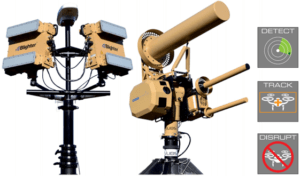
From Jammers to Drones: The Evolving Face of Electronic Warfare
As a former Electronic Warfare Technician, I’ve spent my fair share of time interpreting radar signals, monitoring threat libraries, and operating countermeasure systems designed to protect our ships from incoming missiles. In those days, our primary focus was defending against high-speed, sea-skimming anti-ship missiles, many of which were Soviet-bloc or French-built weapons designed for one purpose: to sink U.S. naval vessels.
Electronic warfare was a chess game played in the RF spectrum—detecting, deceiving, and denying. We trained tirelessly to identify radar emitters, deploy chaff at just the right moment, and manage jamming frequencies to disrupt missile seekers. The equipment was bulky, the signals analog, and the stakes were high. A misidentified radar signature or a delayed response could mean catastrophe.
Fast forward to today, and the world of EW has transformed dramatically. The fundamentals remain—control of the electromagnetic spectrum is still critical—but the players and the tools have changed.
Then: Exocet Missiles and Cold War Tactics
During my service, the threats were relatively linear. Anti-ship missiles like the French-built AM39 Exocet—which gained notoriety during the Falklands War—posed serious challenges. These missiles were sea-skimming, radar-guided, and designed to evade detection until the last moment. We trained to recognize their seeker signatures, respond with the appropriate jamming techniques, and deploy coordinated soft-kill and hard-kill countermeasures.

Our systems, like the AN/SLQ-32, were analog and hands-on. We relied on signal analysis, operator judgment, and quick reactions. The Exocet, like many of its peers, was fast and deadly—but it followed a known playbook, which we drilled into muscle memory.

Now: The Rise of Drones and Networked Threats
Today, electronic warfare is no longer just about jamming radar or spoofing missiles. The battlefield has expanded into cyberspace and into the skies, where unmanned aerial vehicles (UAVs) dominate modern conflict. Drones, both large and small, now carry payloads, gather intelligence, and—increasingly—deploy electronic attacks of their own.
Modern EW systems are networked, AI-assisted, and often deployed across distributed assets. Instead of one ship defending itself, entire task forces or ground units share situational awareness and coordinate electronic attacks in real time. Cloud computing, machine learning, and satellite comms now influence the speed and sophistication of EW tactics.

And perhaps most importantly, the line between offense and defense has blurred. Instead of just jamming enemy radars, we now target their command networks, intercept and manipulate drone communications, and deploy counter-UAV systems that use RF and GPS spoofing to redirect or disable airborne threats.
Reflections from the Deckplates
It’s astonishing to see how far we’ve come—from sweating through missile drills on rolling seas to watching today’s forces manage drone swarms from command centers halfway across the globe. But one thing hasn’t changed: whoever controls the electromagnetic spectrum controls the battlespace.
For those of us who served in the analog era of knobs, scopes, and plotted charts, the digital future of EW can feel almost alien. But at its core, the mission is the same—protect the force, deny the enemy, and dominate the spectrum.

Electronic warfare has always been an invisible fight with very real consequences. And while the tools have changed, the importance of well-trained EW specialists—human or machine-assisted—has only grown.
As someone who cut their teeth countering missile threats like the Exocet, I view the current EW landscape not with nostalgia, but with a sense of awe—and a recognition that the next wave of warfare will be fought not just with bullets and bombs, but with beams, bytes, and bandwidth.

%402x%20(1).svg)
%402x.svg)
%402x.svg)


%402x%20(dark).svg)
%402x%20(dark).svg)
%402x.svg)
%402x.svg)
%402x.svg)